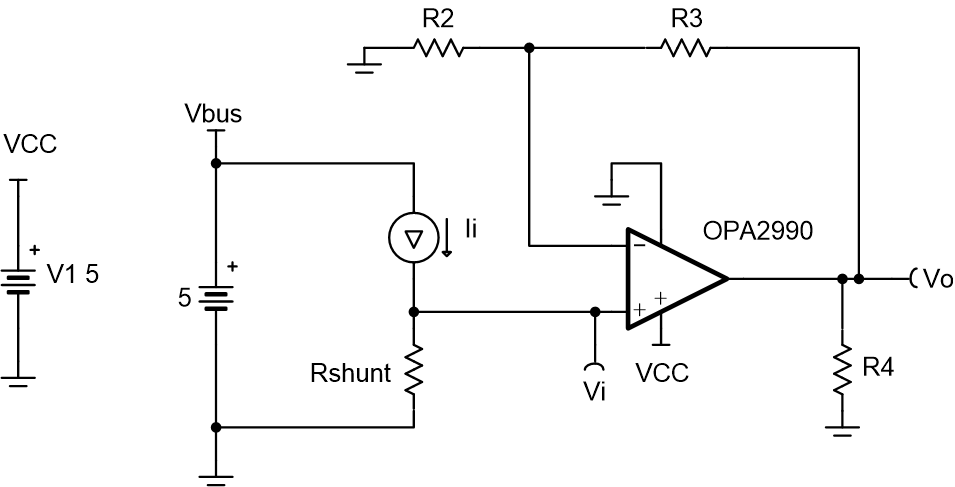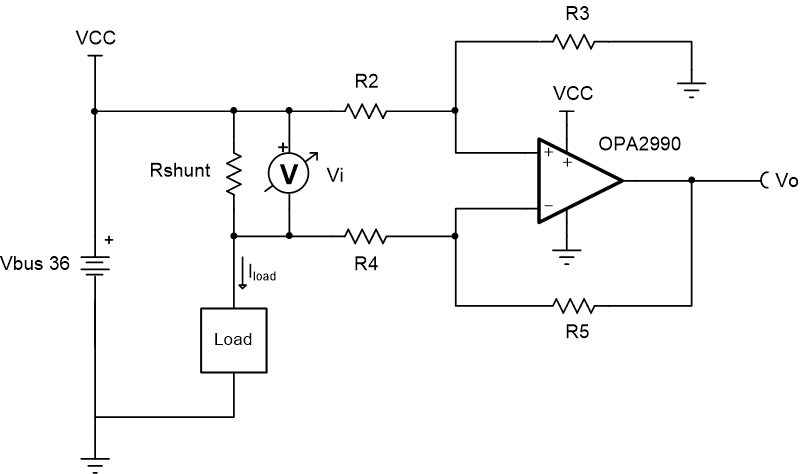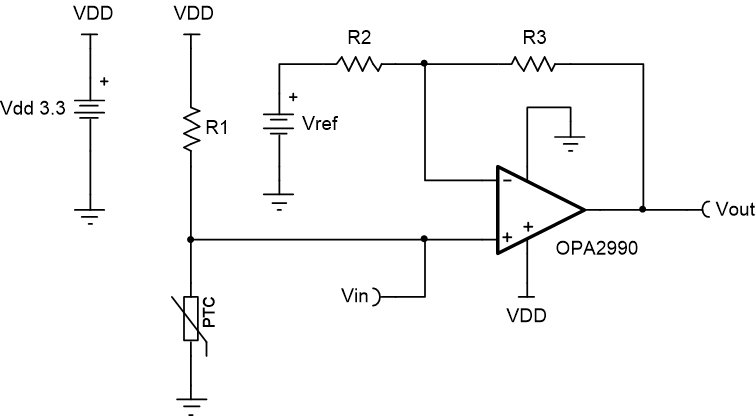SSZT493 April 2019 OPA2191 , OPA2990
Engineers are often faced with the task of selecting multiple operational amplifiers (op amps) to fit the needs of each subsystem on their board, since op amp specifications often vary. This can complicate efforts from procurement to manufacturing.
However, it is possible to satisfy your system requirements with one op amp selection, which will help optimize your pricing and lower your design’s overall cost. Let’s look at how a single op amp can handle three common functions: current sensing, temperature sensing and comparator operation.
Current Sensing
Low-side current sensing is achieved by measuring the voltage drop across a shunt resistor placed between the load and ground, as shown in Figure 1. Low-voltage (5-V) amplifiers typically handle this function. Just because an amplifier has a maximum supply voltage of 36 V or 40 V doesn’t mean that it is limited to high-voltage supplies, however.
 Figure 1 Single-supply Low-side
Unidirectional Current-sensing Circuit
Figure 1 Single-supply Low-side
Unidirectional Current-sensing Circuit| High-voltage and highly versatile amplifiers | |

|
See TI's selection of high-voltage amplifiers providing a wide common mode range, high sensing capabilities and greater supply compatibility. |
Since both of these op amps can operate at 36 V and 40 V, they are also a good fit for high-side current sensing functions. A key benefit of high-side current sensing when compared to low-side current sensing is the ability to detect a short circuit. High-side current sensing uses a difference amplifier topology across a shunt resistor placed between the power supply and the load, as shown in Figure 2.
 Figure 2 High-side Current-sensing Circuit
Figure 2 High-side Current-sensing CircuitYou must consider the common-mode voltage of the op amp when designing a high-side current-sensing circuit. The common-mode voltage is set by the bus voltage and the resistor divider formed by resistor R2 and R3 in Figure 2. Because the common-mode voltage is typically equal to the bus voltage, amplifiers with rail-to-rail inputs and outputs are best for this function. Both the OPA2990 and OPA2191 have rail-to-rail common-mode input ranges and output swings across a wide 36-V (OPA2191) and 40-V (OPA2990) supply.
Temperature Sensing
Temperature sensing is critical in many applications in order to control environmental conditions or ensure safe operating conditions. Systems that measure temperature need to ensure accurate output measurements byscaling and amplifying sensor outputs to harness the full analog-to-digital converter (ADC) resolution. Figure 3 shows how to configure an op amp to sense the resistive output of a positive temperature coefficient (PTC) thermistor and amplify that signal to an ADC.
 Figure 3 Temperature Sensing with PTC Circuit
Figure 3 Temperature Sensing with PTC CircuitThe OPA2990 and OPA2191 can operate across a temperature range from -40°C to 125°C, which is useful for temperature-sensing functions in which the ambient temperature is expected to change significantly. This temperature range also emphasizes the importance of having low-drift op amps. For general-purpose applications, the OPA2990 has an offset drift of 0.5 μV/°C. For a system that requires extremely accurate signals to the ADC, the OPA2191 has a drift of 0.15μV/°C.
Comparator Operation
Amplifiers with multiplexer-friendly inputs are designed so that they can properly interface with the large voltage transients characteristic of multiplexers. These amplifiers’ internal input architecture does not use back-to-back diodes for electrostatic discharge protection, shown in Figure 4a. Instead, these multiplexer-friendly inputs allow for an input differential voltage that extends the full supply voltage range, which makes the OPA2990 and OPA2191 useful in both closed-loop as well as open-loop comparator-like topologies.
 Figure 4 OPA2990 Input Protection Does Not Limit Differential Input Capability (a)
Figure 4 OPA2990 Input Protection Does Not Limit Differential Input Capability (a)Conventional input protection limits differential input capability (b)
Choose the Amplifier Right for You
TI’s new high-voltage amplifiers lower your device count and simplify your bill of materials while satisfying your system requirements with one single op-amp selection. Both the OPA2990 and OPA2191 have very flexible high-voltage options for systems requiring multiple op-amp functions. They can interface with a wide variety of other devices, including multiplexers, sensors and ADCs.